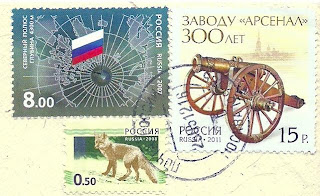The University of California at Berkeley
This beautiful campus, nestled in the Berkeley Hills, is famous throughout the world.
Sent by BlueBat, a postcrosser from California, USA.
This is from Wikipedia : The University of California, Berkeley (also referred to as UC Berkeley, Berkeley, California, or simply Cal) is a public research university located in Berkeley, California, United States. The university occupies 1,232 acres (499 ha) on the eastern side of the San Francisco Bay with the central campus resting on 178 acres (72 ha). Berkeley offers approximately 350 undergraduate andgraduate degree programs in a wide range of disciplines. Established in 1868 as the result of merger of the private College of California and the public Agricultural, Mining, and Mechanical Arts College in Oakland, Berkeley is the oldest of the ten major campuses affiliated with the University of California (UC). Berkeley has been charged with providing both "classical" and "practical" education for the state's people and is generally considered to be the flagship institution in the University of California system. Berkeley co-manages three United States Department of Energy National Laboratories, including the Los Alamos National Laboratory, Lawrence Livermore National Laboratory and Lawrence Berkeley National Laboratory for the U.S. Department of Energy.
Berkeley faculty, alumni, and researchers have won 70 Nobel Prizes, 9 Wolf Prizes, 7 Fields Medals, 15 Turing Awards, 45MacArthur Fellowships, 20 Academy Awards, and 11 Pulitzer Prizes. To date, UC Berkeley and its researchers are associated with 6 chemical elements of the periodic table (Californium, Seaborgium, Berkelium, Einsteinium, Fermium, Lawrencium) andBerkeley Lab has discovered 16 chemical elements in total – more than any other university in the world. Berkeley is a founding member of the Association of American Universities and continues to have very high research activity with $652.4 million in research and development expenditures in 2009. Berkeley physicist J. Robert Oppenheimer was the scientific director of the Manhattan Project that developed the first atomic bomb in the world, which he personally headquartered at Los Alamos, New Mexico, duringWorld War II.
Berkeley student-athletes have won over 100 Olympic medals. Known as the California Golden Bears (often abbreviated as "Cal Bears" or just "Cal"), the athletic teams are members of both the Pacific-12 Conference and the Mountain Pacific Sports Federationin the NCAA. Cal athletes have won national titles in many sports, including football, men's and women's swimming, men's basketball, baseball, men's gymnastics, softball, water polo, rugby, and crew. The official colors of the university and its athletic teams are Yale Blue and California Gold.

























